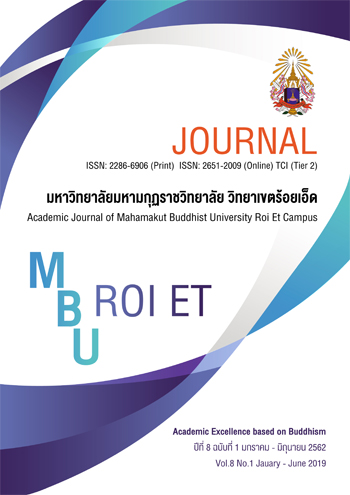The Integration of Dharma Principles for Decreasing the Debt Burden of Teacher Officials, Roi-Kaen-Sala-Sin Group
Main Article Content
Abstract
The objectives of this research were: 1) to study the current situation of integration in Dharma Principles for decreasing the debt burden of teacher officials, Roi-Kaen Sala-Sin Group, 2) to study the integration in Dharma Principles for decreasing the debt burden of teacher officials, Roi-Kaen-Sala-Sin group, and 3) to recommend the guidelines for decreasing the debt burden of teacher officials, Roi-Kaen-Sala-Sin Group. The samples of this study were 241 school administrators and teacher officials. The sample size was determined by using Krejcie and Morgan’ Table. The research instrument was the questionnaire as 5 Level Rating Scale. The IOC were ranged between 0.67-1.00. The reliability was 0.985. Statistics used in data analysis include frequency, percentage, mean, standard deviation, median and inter-quartile range.
The research findings found that:
1. The situation of integration in Dharma Principles for decreasing the debt burden of teacher officials in Roi-Kaen-Sala-Sin Group, in overall, was in “High” level. Considering each aspect, found that every aspect was in “High” level. The aspect with highest level of mean value, included the ĀRAKKHA-SAMPADĀ and Maintenance. The second order included KALYĀNAMITTATĀ, being friends with good persons, UṭṭHĀNASAMAPADĀ, being diligent and persistent. The aspect with lowest level of mean value, included the SAMAJ VITĀ, the appropriate livelihood.
2. The integration of appropriate Dharma Principles for decreasing the debt burden of teacher officials in Roi-Kaen-Sala-Sin Group, DIṭṭHADHAMMIKATTHA-SAMVATTANIKA-DHAMMA 4, were administered.
3. The recommendations for using Dharma Principles for decreasing the debt burden of teacher officials in Roi-Kaen-Sala-Sin Group, DIṭṭHADHAMMIKATTHA principle including 4 issues and 37 indicators : Aspect 1, UṭṭHĀNASAMAPADĀ, being diligent and persistent including 10 indicators, Aspect 2, ĀRAKKHA-SAMPADĀ, maintaining including 9 indicators, Aspect 3, KALYĀNAMITTATĀ, being friends with good persons including 7 indicators, and Aspect 4, SAMAJ VITĀ, appropriate livelihood including 10 indicators.
Article Details
References
ปรียานุช พิบูลสราวุธ. (2550). ปรัชญาของเศรษฐกิจพอเพียงตามแนวพระราชดำริ. กรุงเทพมหานคร : โรงพิมพ์สำนักงานพระพุทธศาสนาแห่งชาติ.
พระครูโพธิธรรมานุกูล (2554). แนวทางการนำหลักทิฏฐธัมมิกัตถประโยชน์เพื่อแก้ปัญหาชีวิตของพุทธศาสนิกชนในสังคมไทยปัจจุบัน. วิทยานิพนธ์ปริญญาพุทธศาสตรมหาบัณฑิต สาขาวิชาพระพุทธศาสนา. บัณฑิตวิทยาลัย : มหาวิทยาลัยมหาจุฬาลงกรณราชวิทยาลัย.
วีระ ปั่นทรัพย์. (2551). การศึกษาสภาพการจัดการเรียนรู้ตามหลักเศรษฐกิจพอเพียงของครูโรงเรียนสังกัดสำนักงานเขตพื้นที่การศึกษาสมุทรสาคร อำเภอเมืองสมุทรสาคร. สารนิพนธ์การศึกษามหาบัณฑิต. บัณฑิตวิทยาลัย : มหาวิทยาลัยศรีนครินทรวิโรฒ.
สำงานคณะกรรมการข้าราชการครูและบุคลากรทางการศึกษา. (2553). คู่มือการปฏิบัติงานของอนุกรรมการใน อ.ก.ค.ศ. เขตพื้นที่การศึกษา และ อ.ก.ค.ศ.ที่ ก.ค.ศ.ตั้งในส่วนราชการ. กรุงเทพมหานคร : โรงพิมพ์มหาวิทยาลัยธรรมศาสตร์.

